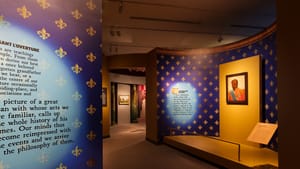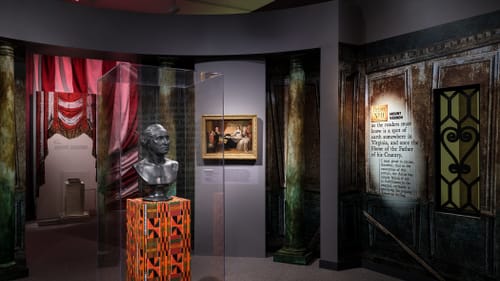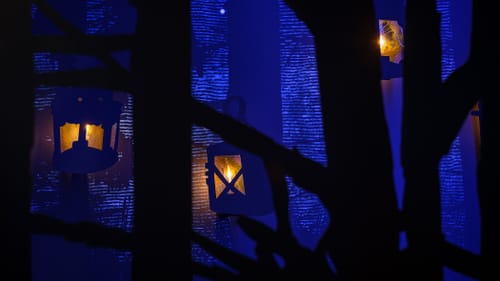Stay in the Loop
BSR publishes on a weekly schedule, with an email newsletter every Wednesday and Thursday morning. There’s no paywall, and subscribing is always free.
A 19th-century activist’s vision becomes a reality today
Winterthur Museum presents Almost Unknown, The Afric-American Picture Gallery

In 1853, New York teacher, journalist, and activist William J. Wilson noted the absence of “distinguished Black” figures in area museums in a piece for Frederick Douglass’ Paper. Six years later, he published a seven-part essay titled The Afric-American Picture Gallery, imagining a museum with 27 portraits that honored Black history and culture. Now, Delaware’s Winterthur Museum makes his vision a reality.
Almost Unknown, The Afric-American Picture Gallery (on view at Winterthur through Sunday, January 4, 2026) is a thoughtful exhibition curated by Dr. Jonathan Michael Square, pulling on new and existing visual art to represent the upper-class Black American society that Wilson envisioned in his 19th-century essay.
Considering slavery’s prevalence during his life and the construct of Black figures as primarily impoverished, Wilson joined a cadre of Black authors who wrote against such one-sided imagery. Joseph and William D. Wilson (unrelated to William J. Wilson) published Sketches of Black Upper-Class Life in Philadelphia in 1841. Between the 1850s and 1890s, William Wells Brown, Frances Ellen Watkins Harper, Charles Chesnutt, and Harriet Wilson all wrote novels about upwardly mobile, socially active Black people. Although slavery was not abolished in the United States until 1865, William J. Wilson’s text portrays free Black people in the United States and beyond to humanize and contextualize them as more than trafficked figures.
Bringing Wilson’s vision to life
His Afric-American essay did not include any drawings, but Wilson was explicit about the ideal art he expected his imagined gallery to contain, like images of 18th-century poet Phillis Wheatley, a heroic portrait of Toussaint Louverture, and a tongue-in-cheek commentary about George Washington’s reliance upon slaves at Mount Vernon.

Many Americans continue to view Black culture through a narrow lens of poverty, music, and entertainment. Fortunately, this Winterthur show highlights significant Black figures, including Wheatley and notable 19th-century writers and activists like Mary Ann Shadd Cary and Thomas Hamilton. Each image portrays either a significant Black figure of African descent (be they Haitian, African, or African American) or a snippet of African American history from enslavement to freedom.
Square did a great job of interpreting Wilson’s text. The entire exhibition is highly accessible to those without an academic background in African American history. For each gallery image, Square includes a quote from the original text, explaining why he selected that image, and then provides historical context. Old hat that I am in African American history, I still learned so much in this exhibition about figures like Haitian commander and president Faustin Soulouque, antebellum Black publications such as the Anglo-American Magazine and the Provincial Freeman, and the abolitionist bent Josiah Wedgwood included in his pottery.
Hats off to the design team. I loved the haunting shadow-box imagery that portrayed fleeing slaves as a Gothic tale. The gallery design's clever, multi-layered quality provides the ability to literally look back and forward through wall cut-outs. Just as Wilson sneakily mocked Washington and 19th-century politics, Square analogizes the past with the present by covertly linking the badge of slave catchers with contemporary ICE agents. He does excellent work following Wilson’s vision while expanding on it and adding gender balance.

As a Philadelphian, I always enjoy when museum exhibitions pull from regional history. Kudos to Square for including the Maryland-based Wye Plantation, which held Frederick Douglass for 18 months.
Behind-the-scenes questions
But the show does have a few drawbacks. For such a racially aware piece, I expected to see more diversity in the exhibition team. However, outside the curator, the key designers appear to be white. The curator appears to be the only person of color in the gallery’s behind-the-scenes video. I felt slightly uncomfortable viewing a white designer replicating Kara Walker’s silhouettes. I wondered why they didn’t just use Walker’s images or a Black creative with their own Gothic aesthetic. Additionally, because the show was so thoughtful in providing busts of Wheatley and Washington earlier in the exhibit, I was disappointed that the statue gallery section was just cardboard cut-outs.
An expansive experience
The African American experience is not limited to slavery and urban plight as a result of ongoing systemic oppression. I get excited whenever contemporary culture (like HBO’s The Gilded Age, Netflix’s biography of Madame CJ Walker, and Hulu’s steampunk series Washington Black) portrays other aspects of Black American life. The Winterthur’s current show is a part of a growing museum trend to highlight middle-class Black culture from the 19th century to today, including CCH Pounder’s Shared Vision collection at the African American Museum in Philadelphia or the Delaware Art Museum’s There Is a Woman in Every Color.
Even if the current federal government is not the future William J. Wilson imagined, this is an excellent and informative experience for adults and kids. And fall is the perfect time to visit Winterthur, walk its gorgeous outdoor paths, and take advantage of its outdoor trolley. While some leaders attempt to elide the contributions of diverse humans to this country, this exhibition spotlights the backbone of American culture.
What, When, Where
Almost Unknown, The Afric-American Picture Gallery. Through January 4, 2026, at Winterthur Museum, 5105 Kennett Pike, Winterthur. $24-$26 (adults, students, seniors); $9 (children aged 3-12). (800) 448-3883 or winterthur.org.
Accessibility
The museum is wheelchair-accessible and provides auxiliary hearing assistance. For more information, visit the Winterthur’s accessibility page.
Sign up for our newsletter
All of the week's new articles, all in one place. Sign up for the free weekly BSR newsletters, and don't miss a conversation.

 An Nichols
An Nichols